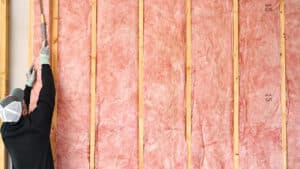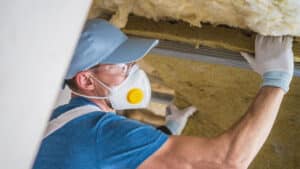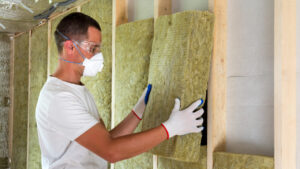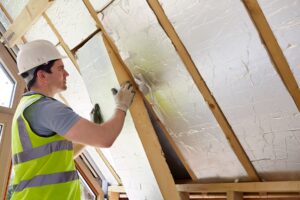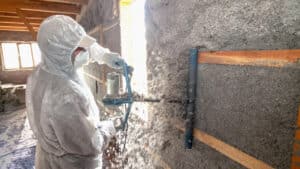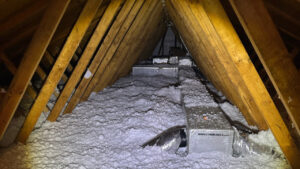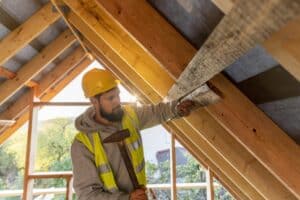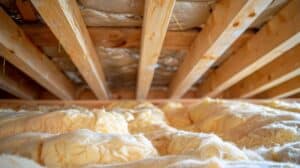You’re aware of the importance of effectively insulating your attic space, but now you face a series of decisions.
Which type of home insulation should you choose? How much insulation is necessary? What’s the recommended R-value for attic insulation? And wait, what exactly does R-value signify?
Devoting time to researching strategies for improving attic insulation is a valuable investment. A good starting point is gaining understanding about insulation R-values.
What is R-Value?
The R-value serves as a crucial factor when determining the necessary insulation for your home. The “R” in R-value stands for resistance and quantifies the heat resistance of insulation materials.
This metric gauges a material’s resistance to heat flow, where higher R-values indicate greater resistance. Energy naturally moves from warmer to cooler areas to reach thermal equilibrium, making it evident that during winter, your home’s heat seeks to escape. By increasing insulation levels, you can reduce energy consumption to maintain a warm house. The resulting benefits include enhanced energy efficiency, reduced heat loss, and lower utility expenses.
In warmer climates, external heat can easily infiltrate your home. Proper insulation, particularly in the attic, along with floors, exterior walls, and crawl spaces, is essential to minimize cooling costs and limit heat transfer.
Different sections of your home require different R-values. As heat tends to rise and escape through the attic, attics demand a higher R-value than wall insulation does.
If you live in Virginia Beach you live in Climate Zone 4 and should prepare your home accordingly. While the process may seem overwhelming, you don’t have to navigate it alone. A certified attic specialist like us can guide you through crucial decisions weather atticcting the right R-value for Virginia weatherattic insulation, determining the appropriate quantity of insulation, and more.
Recommended Insulation R-Values for Virginia Homes : Climate Zone 4
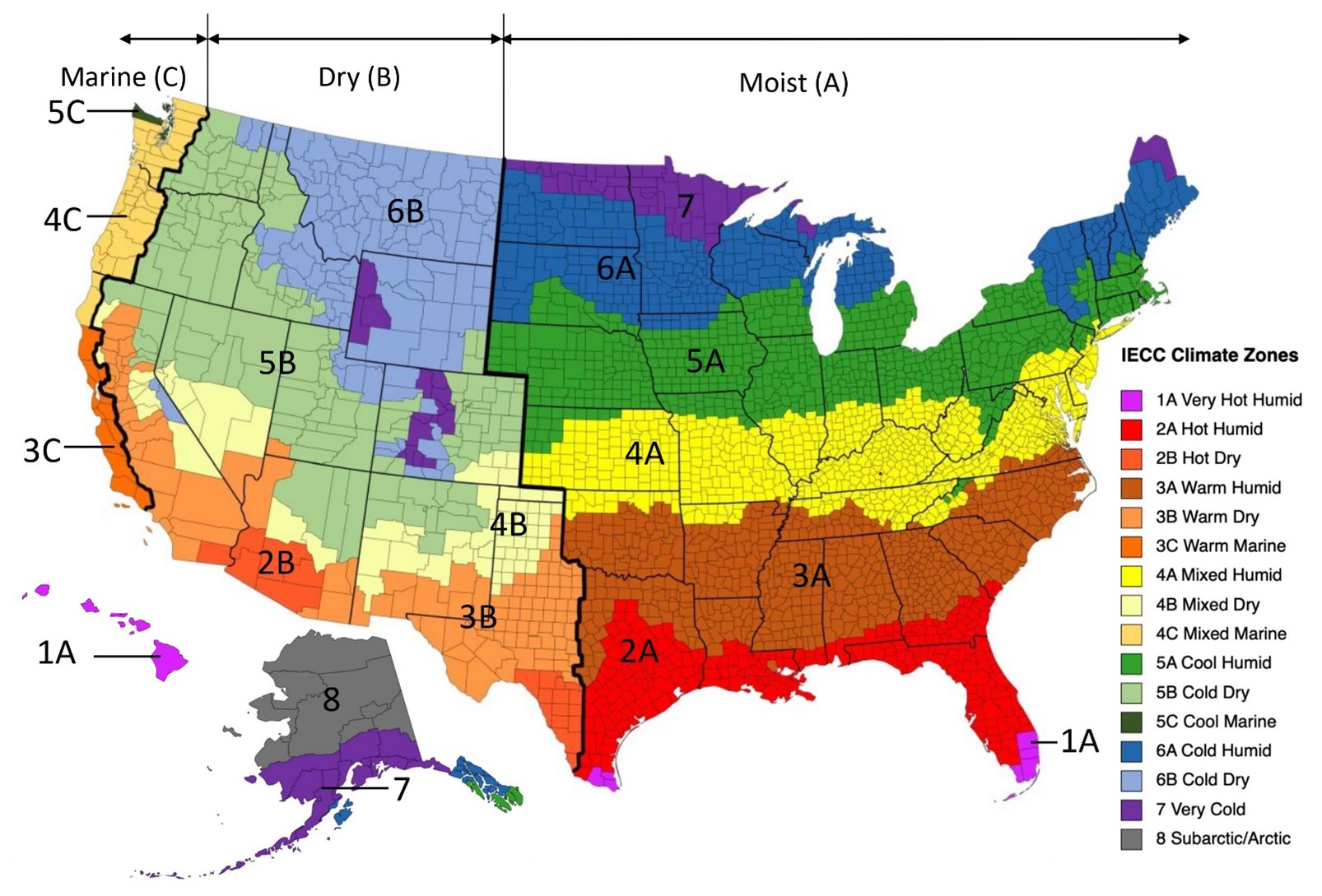
| Zone | Add Insulation to Attic | Floor | |
| If your attic is uninsulated | If you already have 3–4 inches of insulation | ||
| 1 | R30 | R25 | R13 |
| 2 | R49 | R38 | R13 |
| 3 | R49 | R38 | R19 |
| 4A and 4B | R60 | R49 | R19 |
| 6, 5, and 4C | R60 | R49 | R30 |
| 7 and 8 | R60 | R49 | R38 |
Wall Insulation (Above Ground): When exterior siding is taken off from a wall:
Uninsulated Wood-Frame Wall:
Drill openings in the sheathing and inject insulation into the vacant wall cavity prior to installing the new siding. Additionally:
– In Zone 3, incorporate R5 insulative wall sheathing beneath the new siding.
– In Zones 4–8, include insulative wall sheathing with an R5 to R10 rating beneath the
Insulated 2×4 wood-frame wall:
– In Zones 4–8, include R10 insulative wall sheathing beneath the new siding.
Basement or Crawlspace Wall Insulation:
– Zone 3: Choose between R5 insulative wall sheathing or R13 batt insulation.
– Zones 4A and 4B: Opt for R10 insulative wall sheathing or R13 batt insulation.
– Zones 4C and 5–8: Select either R15 insulative wall sheathing or R19 batt insulation.
Note: This advice relies on information from the 2021 International Energy Conservation Code (IECC) Residential Provisions Chapter 4 Table R402.1.3. Refer to the Code for more detailed guidance.
Best Options For Your Attic Insulation

Determining the ideal insulation for Virginia attics involves considering various factors, such as your home’s design, attic condition, and budget.
In most attics in Hampton Roads, three main materials are commonly utilized:
2. Fiberglass Insulation:
– Fiberglass insulation is a popular choice for attic insulation due to its affordability, ease of installation, and effectiveness in reducing heat transfer. It is available in batts, rolls, or blown-in form and can be installed over existing insulation.
– R-Value: Typically between 3.1 and 3.4 per inch. Rigid foam board is also a fantastic alternative to fiberglass batt insulation.
3. Spray Foam Insulation:
– Even though spray foam insulation comes with a higher price tag, it provides outstanding insulation and forms an airtight seal that prevents air leaks and moisture buildup. This is especially helpful for attics with unique shapes and difficult-to-access areas, which is crucial in Virginia’s changing climate where moisture control is important.
– R-Value: In open-cell spray foam installations, the average R-value ranges from 3.5 to 3.6. In closed-cell spray foam installations, the average ranges from 6.0 to 6.5.
4. Cellulose Insulation:
– Cellulose insulation is a great option for attics. It’s made from recycled newspaper treated with a fire retardant, eco-friendly, and does an excellent job reducing heat transfer. Plus, it can be blown in to fill small gaps and crevices easily.
R-Value: Ranges from 3.2 to 3.9, depending on how densely it is packed after installation, offering good insulation and air-sealing efficiency.
In the end, choosing the right insulation for your Virginia attic relies on your home’s individual requirements and budget. We suggest seeking advice from a licensed insulation contractor to identify the most fitting option for your home.
Are there incentives for adding attic insulation in Virginia?
Yes, you can get rewards for adding insulation in your Virginia attic. Here are some options:
– Utility Rebates: Many Virginia utility companies give money back for upgrading insulation. The amount varies, but it can be a few hundred dollars. Check with your local utility to see what rebates they offer. Virginia Energy, for instance, has a program that might include incentives for insulation upgrades.
– Virginia Energy Efficiency Financing: Virginia provides money options to help homeowners with energy-saving changes, like insulation upgrades. These programs might offer low-interest loans or other financial perks to make these improvements more affordable. You can get details from local energy efficiency programs or financial institutions.
– Federal Tax Credits: The government gives tax credits for certain energy-efficient home improvements, including insulation upgrades. You can claim a credit for a percentage of the insulation cost, up to specific limits. Here are some details on eligible products and how to claim the credit.
Remember to check with the specific program or utility company for the latest info on incentives. Some programs might have specific rules or limits. Some could need approval before you get the incentive.
Calculating the Ideal R-Value for Your Attic
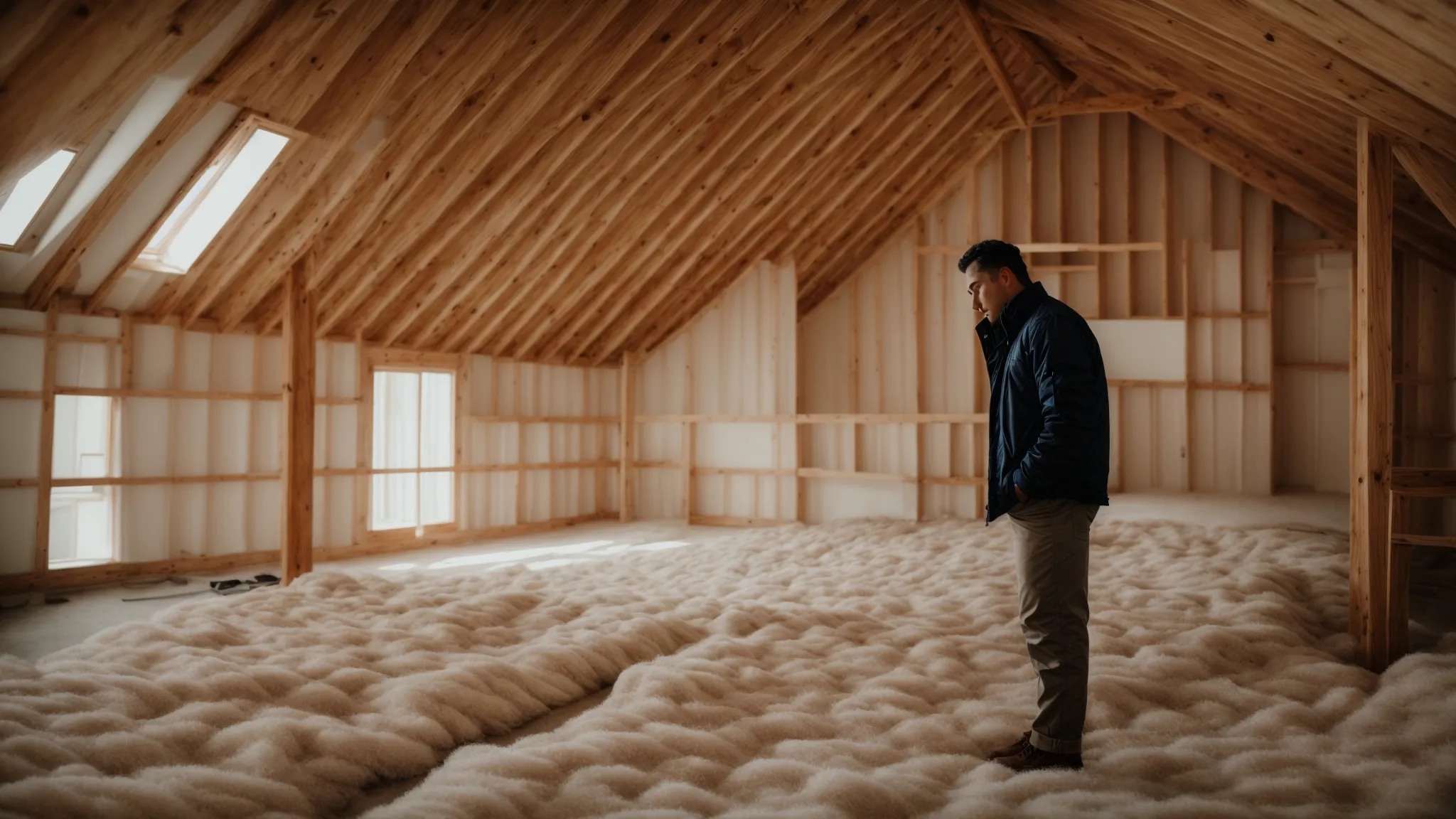
Determining the appropriate R-value for your attic insulation is crucial for maintaining energy efficiency and comfort in your home. Here’s a systematic approach to guide you through the process:
1. Consider Geographical Location and Climate Zone:
– Take into account your geographical location and climate zone. Different regions have varying temperature requirements, influencing the insulation needs. This information is crucial in determining the ideal R-value for your attic. If you are a resident of Hamton Roads then you should design your insulation in Climate Zone 4.
2. Assess Home Size:
– Evaluate the size of your home. Larger homes typically require more insulation to regulate temperatures consistently. Measure the square footage of your attic space to estimate the quantity of insulation needed.
3. Factor in Heating and Cooling Systems:
– Consider the type of heating and cooling systems in your home. More efficient systems may require less insulation to achieve the desired comfort levels, while older systems may necessitate additional insulation to compensate for inefficiencies.
4. Evaluate Existing Insulation:
– Assess any existing insulation in your attic. Check its condition and note the current R-value. It’s often possible to enhance insulation efficiency by adding new layers on top of the existing insulation.
5. Consult a Certified Attic Specialist:
– For precise recommendations, consult a certified attic specialist. They can conduct a thorough assessment of your attic, considering all relevant factors, and provide expert guidance on the ideal R-value for your specific situation.
Remember that achieving the right R-value is essential for energy efficiency and overall comfort. Investing time and effort in this calculation, along with seeking professional advice, is a worthwhile step towards optimizing your home’s insulation.
Common Misconceptions About Attic Insulation

Certainly, misconceptions about attic insulation can lead to inaccurate decisions regarding R-values. Here are some common misconceptions to be aware of:
Thicker Insulation Is Always Better
Increasing the thickness of insulation is crucial up to a certain point, but excessive insulation can trap moisture, resulting in problems such as mold and rot.
All Material Types Are the Same
Selecting the appropriate insulation type is essential as different types possess unique properties and R-values. This choice is critical to meet your specific requirements and adapt to the climate effectively.
Insulation Lasts Forever
Insulation may settle or degrade over time, diminishing its effectiveness. Regular inspection and maintenance are crucial to ensure optimal performance.
DIY Always Saves Money
Although DIY insulation projects can be cost-effective, they might lack the expertise necessary for optimal results. Professional installation can ultimately save energy and money in the long run.
DIY vs. Professional Installation: What’s Right for You?

When it comes to attic insulation, you have two primary options: DIY or professional installation.
DIY Attic Insulation offers the advantages of cost savings on labor, suitability for small projects, and flexibility in scheduling. However, it may lack the expertise for accurate R-value calculations, carries a risk of improper installation, and limits access to professional equipment and materials.
Professional Attic Insulation, on the other hand, ensures an accurate R-value assessment, expertise in insulation types and installation techniques, and guaranteed quality and efficiency. However, it comes with a higher upfront cost, requires scheduling and coordination with professionals, and may have a lead time for appointments.
Deciding if you should do it yourself or hire a professional depends on your budget, time, and how sure you are about your skills. Getting a certified attic specialist is usually better for big projects or when you’re not sure about the calculations. It’s smarter to get professional help than try to do everything yourself.
Beyond R-Value: Other Factors to Consider in Attic Insulation

Achieving efficient attic insulation requires homeowners to take into account more than just R-value; additional factors to consider include:
Insulation Age
To sustain efficiency, conduct regular inspections and replace insulation as necessary, as it may deteriorate over time.
Construction Materials
In older homes with less efficient construction, higher R-values may be necessary to offset heat loss.
Occupancy
The number of occupants influences heat generation and insulation requirements, with larger families potentially necessitating additional insulation.
Ventilation
Good attic ventilation isn’t a luxury. It stops harmful moisture buildup and fights heat buildup, keeping your insulation effective. A careful balance between air intake and exhaust preserves your insulation’s life and boosts your home’s comfort.
Energy Efficiency Upgrades
Boosting your home’s energy efficiency involves more than relying solely on attic insulation. Smart decisions such as energy-efficient windows, LED lighting, and high-efficiency HVAC systems work together with upgraded insulation to reduce energy consumption, maximize savings, and create a home that is not just well-insulated but thoroughly efficient.
Eco-Friendly Insulation Options for Attics

When it comes to attic insulation, homeowners are increasingly exploring eco-friendly options to boost energy efficiency and minimize environmental impact. Sustainable materials like recycled denim, wool, and cellulose insulation have gained popularity as eco-conscious alternatives to traditional insulation.
Recycled denim insulation, crafted from post-consumer jeans, offers a creative way to repurpose old clothing. It serves as a highly efficient insulator, boasting excellent thermal performance and sound absorption properties, all without harmful chemicals.
Wool insulation, derived from sheep’s wool, stands out as a renewable and biodegradable option. Known for its natural fire resistance and moisture-wicking capabilities, wool insulation is an environmentally friendly choice.
Cellulose insulation, composed of recycled paper and treated to be fire-resistant and insect-repellent, is another green option. Choosing these sustainable insulation materials not only enhances home energy efficiency but also aligns with environmentally responsible practices.
Cost Considerations: Balancing Efficiency and Affordability

Cost is a crucial factor in deciding on attic insulation. Striking a balance between insulation efficiency and budget constraints is essential for making informed choices. Various cost factors, including material cost, installation labor, and long-term energy savings, come into play when considering different types of attic insulation.
Fiberglass batts and blown-in fiberglass are cost-effective choices, providing reasonable R-values at a budget-friendly price point. Although spray foam insulation has a higher upfront cost, it delivers excellent insulation performance and potential long-term savings due to its high R-value and air-sealing properties.
To find the right balance, it’s important to assess your specific needs and budget. Conduct a cost-benefit analysis considering the initial investment and potential energy savings over the insulation’s lifespan. Additionally, explore available rebates, tax incentives, and financing options to help offset upfront costs.
Consulting with insulation professionals can offer valuable insights into achieving optimal efficiency while staying within your budget. Ultimately, the goal is to strike a balance that ensures a comfortable and energy-efficient home without exceeding financial limits.
Contact Universal Insulation Doctor for all your Attic Insulation Needs!

Ready to enhance your attic’s R-Value and energy efficiency? Count on Universal Insulation Doctor. Our experienced team offers customized insulation solutions tailored to the unique needs of your Virginia Beach home.
With precision and expertise, we evaluate your current insulation and deliver upgrades that make a difference. Whether it’s blown attic insulation or spray foam applications, we prioritize your comfort, creating a shield against Virginia’s ever-changing climate.
Don’t let energy costs spiral out of control. Contact Universal Insulation Doctor today to secure the comfort and savings your Hampton Roads residence deserves. Your journey to A Well-Insulated Home starts with just one call.

